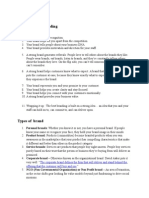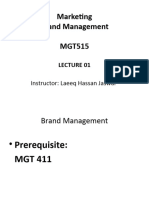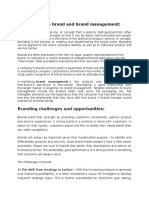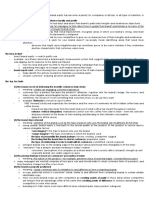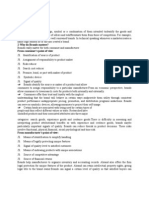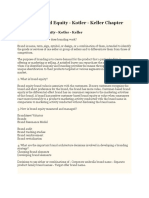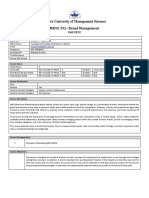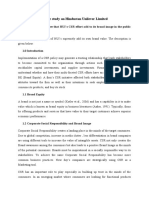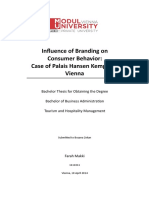Chapter 10
1. The Role of Brands
• A brand is a name, term, design, symbol, or any other feature that identifies a seller’s product
and differentiates it from competitors.
• Brands simplify decision-making for consumers by assuring quality, reducing risk, and setting
expectations.
• Brand value is not just for the consumer; it also helps companies by fostering customer loyalty
and enabling premium pricing.
2. How Does Branding Work?
• Branding creates an emotional connection: Strong brands connect emotionally with consumers,
creating a sense of trust and loyalty.
• Brands as an experience: Consumers experience brands through multiple touchpoints such as
advertising, products, customer service, and social media presence.
• Brand associations: Consumers develop specific thoughts, feelings, perceptions, and attitudes
toward brands, which are key to long-term loyalty.
3. Brand Equity and Brand Power
• Brand equity refers to the added value a brand brings to a product beyond its functional
attributes.
• Key components of brand equity:
1. Brand awareness: Consumers' ability to recognize or recall a brand.
2. Brand associations: What consumers link to the brand (e.g., quality, innovation).
3. Perceived quality: Consumers’ perception of the brand's quality.
4. Brand loyalty: The commitment to repeatedly purchase a specific brand.
• Brand power: A brand’s influence on consumer buying behavior and its ability to create strong
emotional connections. Strong brands can charge higher prices and resist competition.
4. Designing the Brand
• Defining the Brand Mantra:
o A brand mantra is a short, three- to five-word phrase that captures the brand's essence.
It should communicate the brand's positioning and what it represents.
� o Example: Nike’s brand mantra is “Authentic Athletic Performance.”
• Choosing Brand Elements:
o Brand elements include the brand name, logo, symbol, and slogan, which should be
distinctive, memorable, and versatile.
o Criteria for effective brand elements:
1. Memorable: Easy to recognize and recall.
2. Meaningful: Communicates the brand’s values.
3. Adaptable: Works across cultures and time periods.
• The Magic of Brand Characters:
o Using brand characters (e.g., Tony the Tiger, Michelin Man) can humanize a brand, make
it more relatable, and create a lasting impression.
5. Brand Hierarchy and Brand Portfolio
• Brand Hierarchy:
o Brands often operate under a hierarchy, where sub-brands exist within larger parent
brands. This strategy helps companies market diverse products while maintaining a
strong overall brand identity.
• Managing Brand Portfolios:
o Brand portfolio management involves handling multiple brands in a way that maximizes
each brand’s contribution to the overall company’s goals.
o Cobranding: This strategy involves partnering with another brand to offer a product or
service (e.g., Apple’s collaboration with Nike).
o Brand extensions: Leveraging a well-established brand name to introduce new products,
which helps reduce marketing costs and increase the likelihood of success.
6. Brand Dynamics and Repositioning
• Brand Repositioning:
o Sometimes brands need to reposition themselves to remain relevant in the market (e.g.,
Old Spice’s repositioning from targeting older men to appealing to younger audiences).
• Brand Extensions:
o Line extension: Expanding a brand’s product line within the same category (e.g., new
flavors or sizes).
� o Category extension: Expanding into new product categories (e.g., Dove moving from
soap to hair care products).
7. Managing a Brand Crisis
• Brands may encounter crises (e.g., product recalls, public relations scandals) that can damage
their reputation.
• Crisis management involves addressing the issue quickly, taking responsibility, and restoring
trust through transparency and corrective actions.
8. Luxury Branding
• Characteristics of Luxury Brands:
o Luxury brands rely heavily on their image, exclusivity, and superior quality. They offer a
status symbol and a sense of belonging to an elite group.
• Managing Luxury Brands:
o Luxury brands must carefully manage their scarcity and exclusivity, ensuring that they
are not diluted by overextension or frequent discounts.
Summary:
Building a strong brand involves more than just creating a recognizable name. It requires a deep
understanding of consumer needs, strong brand elements, and a long-term strategy for maintaining
brand equity. Through careful management, brands can extend their influence, create customer loyalty,
and navigate market challenges.










